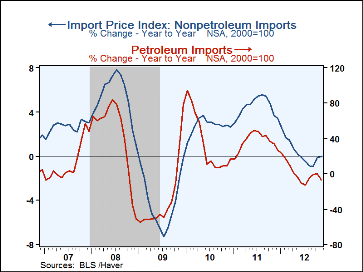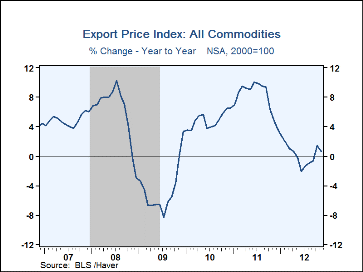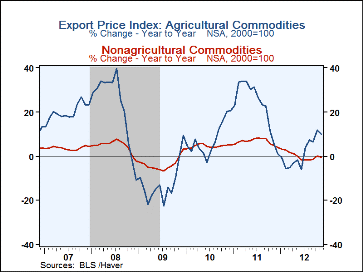 Global| Dec 12 2012
Global| Dec 12 2012U.S. Import Prices Ease With Lower Oil Prices
by:Tom Moeller
|in:Economy in Brief
Summary
Declines in petroleum prices lowered overall U.S. import costs by 0.9% last month and by 1.6% y/y. That followed a 0.3% October rise, initially reported as 1.5%. The Action Economics survey looked for a 0.5% fall. Petroleum prices led [...]
Declines in petroleum prices lowered overall U.S. import costs by 0.9% last month and by 1.6% y/y. That followed a 0.3% October rise, initially reported as 1.5%. The Action Economics survey looked for a 0.5% fall. Petroleum prices led the decline with a 3.6% drop (-7.0% y/y) after prices fell 0.2% during October.
Nonpetroleum import prices slipped 0.1% and were unchanged y/y. The decline was led by a 1.3% drop (-2.1% y/y) in foods, feeds & beverages prices. Computers, peripheral & semiconductor costs also fell by 0.6% (-0.9% y/y) and nonauto consumer goods prices slipped 0.1% (+0.3% y/y). Nonoil industrial supplies & material prices rose 0.5% (-1.6% y/y). Automotive vehicle costs were unchanged (1.6% y/y) as were capital goods prices (1.0% y/y) outside the high-tech area.
U.S. export prices fell 0.7% (+0.7% y/y) in November, led lower by a nonagricultural commodity prices which also were down 0.7% (-0.4% y/y). Nonauto consumer goods prices were off 0.2% (-0.2% y/y) but capital goods costs rose 0.2% (1.2% y/y). Automotive vehicles & product prices were unchanged (0.4% y/y). Agricultural product prices ticked up 0.1% but by 10.0% y/y. Strength has been led by a 24.4% y/y rise in soybean prices and a 21.2% yearly gain in feedstuff prices.
The import and export price series can be found in Haver's USECON database. Detailed figures are available in the USINT database. The expectations figure is in the AS1REPNA database.
Part Chart, Part Science: The Evolution of Economic Indicators from the Federal Reserve Bank of Atlanta can be found here.
| Import/Export Prices (NSA, %) | Nov | Oct | Sep | Nov Y/Y | 2011 | 2010 | 2009 |
|---|---|---|---|---|---|---|---|
| Imports - All Commodities | -0.9 | 0.3 | 1.0 | -1.6 | 10.9 | 6.9 | -11.5 |
| Petroleum | -3.6 | -0.2 | 4.0 | -7.0 | 36.5 | 28.4 | -35.9 |
| Nonpetroleum | -0.1 | 0.4 | 0.1 | 0.0 | 4.5 | 2.8 | -4.1 |
| Exports - All Commodities | -0.7 | 0.0 | 0.8 | 0.7 | 8.1 | 4.9 | -4.6 |
| Agricultural | 0.1 | -1.9 | 1.3 | 10.0 | 22.3 | 7.9 | -12.8 |
| Nonagricultural | -0.7 | 0.2 | 0.7 | -0.4 | 6.6 | 4.6 | -3.7 |
Tom Moeller
AuthorMore in Author Profile »Prior to joining Haver Analytics in 2000, Mr. Moeller worked as the Economist at Chancellor Capital Management from 1985 to 1999. There, he developed comprehensive economic forecasts and interpreted economic data for equity and fixed income portfolio managers. Also at Chancellor, Mr. Moeller worked as an equity analyst and was responsible for researching and rating companies in the economically sensitive automobile and housing industries for investment in Chancellor’s equity portfolio. Prior to joining Chancellor, Mr. Moeller was an Economist at Citibank from 1979 to 1984. He also analyzed pricing behavior in the metals industry for the Council on Wage and Price Stability in Washington, D.C. In 1999, Mr. Moeller received the award for most accurate forecast from the Forecasters' Club of New York. From 1990 to 1992 he was President of the New York Association for Business Economists. Mr. Moeller earned an M.B.A. in Finance from Fordham University, where he graduated in 1987. He holds a Bachelor of Arts in Economics from George Washington University.










